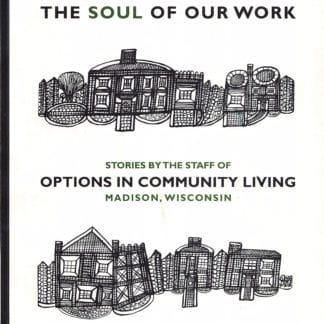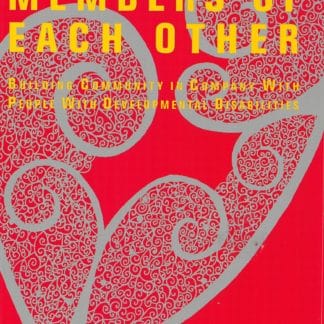by Judith Snow, MA
Abstract: In her typical forthright way, Judith peels back the layers of misunderstanding about the nature of Personal Assistance – and reminds us of the very simple truth – is a form of support for people who are labeled disabled.
Personal assistance is a form of support for people who are labeled disabled. People who have been given a disability label are people who have an unusual limitation in their physical functions, their thinking and/or their emotional expression. For example, they may use a wheelchair for mobility, or their speech may be inarticulate or they may have thoughts and perceptions that other people don’t have.
Until recently society has had only four responses to a person who becomes classified as disabled as a result of birth anomalies, injury or illness. The first response is to go to great efforts to bring or return the person to “normal” functioning – whatever “normal” is in any particular society. When these efforts are successful a person can keep their status as an “ordinary citizen”.
For example, great strides were made in medical and rehabilitative technology to support injured veterans of World War II. In addition governments provided housing and education vouchers to any soldiers who could use them. As a result many veterans that formerly would have not survived, or would have remained isolated and dependent in hospitals, instead became neighbours in communities everywhere.
When a person cannot achieve “normal” status, sometimes their differences opened a specific role for them in their community. For example, until very recently, a person with visual impairment would expect to learn to cane chairs and the community would expect that role to be reserved for that individual. Formerly, in some aboriginal communities, a person who had thoughts considered irrational would become a wandering storyteller, freely seeking and receiving friendship, food and shelter for weeks at a time in different homes.
When these responses to troubling differences don’t work, compassionate custodial care has often been the next response. People with different abilities frequently spent their lives in home-bound or institution-bound situations, being looked after and/or guarded by others. Thus communities everywhere often supported, and still maintain, asylums of various types.
Sometimes there has been no available and willing caregiver, no “special” role and no asylum. To this day vulnerable people are sometimes killed or “allowed to die”.
In the last fifty years many people with physical, cognitive or emotional support needs, along with family and friends, have fought for the opportunity to live, work, and participate like “regular folk”. They needed a different response than society has been accustomed to providing. They weren’t going to become “normal”, they didn’t want to settle for stereotypical roles, they didn’t need to be “cared for” and they certainly weren’t prepared to die. Leaders invented the unique support they required and fought to make it widely available.
They invented personal assistance. What is personal assistance? It is not being a nurse, a butler or a housekeeper although at times it may resemble these roles. Personal assistance is functional support provided through a personal relationship. It is a response that makes it possible for people with unusual abilities to participate fully in the community, contribute to society…. and have great lives.
Personal assistance involves assisting in the daily tasks that a person cannot carry out by themselves or that they find so time consuming as to interfere with other important activities. These tasks fall in the areas of hygiene, nutrition, grooming, mobility, and communication. The need to perform these tasks can arise anywhere, any time – at home, at work, out shopping, visiting friends, etc. Personal assistants are the important “sidekicks” who assist people with these essential activities, making everyday participation a reality.
The types of tasks performed by personal assistants are the same in all situations. The actual functions vary depending on the individual who is being supported. For example, one individual who uses a wheelchair and is an accountant may require help with showering (hygiene), food preparation (nutrition), support to get into a suit and tie (grooming), chauffeuring of their accessible van (mobility), and filing and desk set up at work (communication). A person who has cognitive differences and owns her own baking business may require someone to remind her about showering (hygiene), make a shopping list with her for her home and business kitchens (nutrition), coach her on clothing selection (grooming), assist with budgeting for bus tickets (mobility), and do invoicing and bookkeeping for her baking business (communication). A third person who has extreme mood swings and is an artist may need physical assistance to bathe when depressed, coaching in food selection, reminders about the need to shop for clothes, support to recognize when not to drive, and assistance with advertising and selling creations.
Personal assistance is paradoxical in nature. Like other forms of support, well executed personal assistance is nearly transparent. Just as I don’t want to be conscious of the elevator that is transporting me hundreds of feet in the air, and I soon stop noticing the hum of the refrigerator that is preserving a week’s supply of food, a skilled personal assistant can perform his or her functions without overshadowing the contributions and personality of the person who is being assisted. When I am giving a speech to two thousand people, the audience remains unaware of the bathing, grooming, wheelchair maintenance, chauffeuring, and note taking that got me to the podium.
Unlike an elevator or refrigerator, though, the person of the personal assistant is an essential element of the job. Personal assistance is an ongoing transaction between two people. It is a dance which is led by the person who is building and fulfilling their place in the community and who relies on the interface their assistant provides to be able to function in an otherwise inaccessible world.
Each person in the dance must be fully committed to the dance. The personality, interests and skills of the assistant and the supported person must complement each other. Each must bring a willingness to be with each other, open themselves to each other, be honest, straightforward and respectful, and each must responsibly ensure that the leader of the dance really leads. The leader is, of course, the supported individual.
Personally, I hire only energetic people who love to drive, are physically well and strong, and who are motivated to change the world. Why? Because I travel a lot as part of my work, I am active for fourteen to eighteen hours a day, I go into inaccessible places fairly often and I am an activist building an Inclusive world. My personal assistants have to be quick, strong and motivated just to keep up with me. Another person with the same sort of quadriplegia could be much more interested than I am in neighbourhood activities, like gardening, church and going to movies and theatre. Their personal assistants would need to very different persons.
These essential qualities of personal assistance — transparency and relationship — are rarely understood or recognized. A number of standard practices still exist that diminish the potential of this support. First, individuals are rarely provided with the money and the opportunity to hire their own assistants. Instead money flows to agencies and schools which, in turn, hire a cadre of workers and assign them a “case load”. Supported individuals have no choice over the identity of their assistants, their job descriptions, or the type and means of their training. Consequently, the personal nature of the working relationship doesn’t get established and the support doesn’t become transparent. The subsequent activity cannot lead to sustained community participation.
Another limitation on the full development of personal assistance has been that resources are typically doled out in meager amounts. Most personal assistants are underpaid and so leave their jobs too soon. This creates instability and emotional stress for the supported individual, their family and friends. Also, because of lack of funds, many people who use personal assistance have fewer hours of support than they really need to become full participants in society. While nursing and group homes still have ample resources and continue to contribute to isolation and dependence, the support that truly leads to community participation is rendered inadequate.
Yet another limitation on the full development of personal assistance has been that resources typically are allocated only to individuals who can already show that they can direct their own “care”, or to family members of those who have the “potential” to be self directing. This leads to a vicious circle. Personal assistance creates the capacity to be responsible. Without personal assistance many individuals who function in unusual ways have no means to develop and demonstrate their own capacity to create and manage their community roles and personal accountabilities. If access to personal assistance depends on first demonstrating capacity, many individuals will forever remain segregated and helpless.
In 1979 I was a chronically ill patient in a state supported hospital for people who are expected to die of their physical problems. In 2001 I am a self employed homeowner who works internationally, employing four individuals. Neither my physical limitations nor my mental acuity have changed much over the years. What did change was that the province of Ontario, Canada was persuaded in 1980 to pay me to hire my own personal assistants. I was put in the driver’s seat of my own life.
Another limitation on the acceptance of personal assistance as the ideal support vehicle is that the powerfully personal nature of good support rarely gets recognized and nurtured. A well supported individual and a truly attentive personal assistant typically form a good friendship – one that often lasts long after the job has ended, and may even deepen into love. Agencies often try to ignore or forbid such intimacy, leaving both supported individual and assistant vulnerable to a host of difficulties.
Confusion of roles, emotional fragility, misunderstandings, even abuse are rampant in agency-driven support. Caregivers blame the clients and the service users blame the agency and staff. In reality, the problems arise because the essentially intimate nature of personal assistance is being ignored or suppressed. Rather than guide and encourage two people to take on a uniquely vibrant journey in their lives, agency driven policy usually assumes that nothing is going on and mandates that nothing will happen — instituting denial. Both people are expected to act like robots, and the capacity of the relationship is diminished, leading to less participation from supported individuals and dissatisfaction among workers.
In reality intimacy is an ordinary aspect of personal assistance. This intimacy is not sexual. It arises because people are in physical and emotional contact, sharing a deeply personal experience. Their communication has the potential to reach profound, nonverbal levels. Any intimacy has the capacity to spark love and hate. Personal assistants and supported individuals experience this emotional, spiritual roller coaster as an almost daily matter of their lives. This must be recognized as a fact. People on both sides of the relationship must be offered support to recognize the true nature, value and power of their experience.
I have an active support circle of friends and colleagues. I also have four to six personal assistants at any particular time. Several members of my support circle make themselves available to hear assistants’ concerns, explanations and proposed solutions. My support circle does the same for me. From time to time, and especially when there is a problem, a circle member will bring us together so we can talk about our realities.
Many of my personal assistants have worked for me for at least three years. Several have remain my friends long after working for me. I believe that this has been made possible because we are sustained by my community in negotiating the intimate aspects of our journey together.
Personal assistance is an essential evolution in human support. It makes it possible for a much wider diversity of people to live, thrive and take their place in the world. As a community support, personal assistance deserves better funding, deeper understanding, greater visibility and wider availability. Governments must adopt personal assistance as the support of first choice, not last. Schools must list personal assistance as a valued career choice. We all must recognize that this support is as essential to fifteen percent of our population as transportation and sewage disposal is to all citizens. Our communities will be stronger when we recognize, celebrate and adequately resource this relationship-based vehicle for creating and sustaining full participation.
Judith Snow – Writing & Videos




